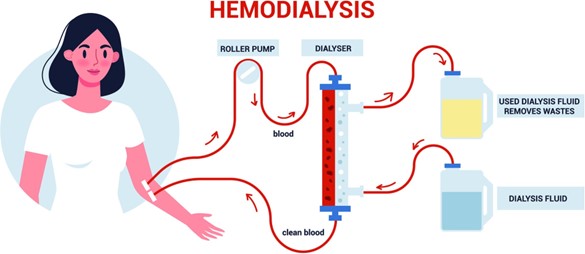A male client with acute kidney injury (AKI) is scheduled for his first hemodialysis treatment and asks the practical nurse (PN) how the treatments will be evaluated for effectiveness. The PN explains that blood samples will be collected for analysis. Which laboratory value should the PN explain as the best indicator of each hemodialysis?
Elevated potassium.
Decreased calcium.
Lowered hemoglobin.
Decreased creatinine.
The Correct Answer is D
Hemodialysis is a procedure used to remove waste products and excess fluid from the blood when the kidneys are unable to function properly. One of the waste products that accumulate in the blood during kidney dysfunction is creatinine. Creatinine is a byproduct of muscle metabolism, and its levels in the blood are normally regulated and eliminated by the kidneys. In AKI, the kidneys are not able to effectively filter and eliminate creatinine, leading to elevated levels in the blood. Hemodialysis helps to remove excess creatinine from the blood, resulting in decreased creatinine levels.

A- Elevated potassium levels (hyperkalemia) are common in AKI and can be life-threatening. Hemodialysis helps to remove excess potassium from the blood, restoring normal levels.
However, the best indicator of the effectiveness of hemodialysis in managing hyperkalemia would be monitoring the potassium levels before and after the session rather than considering it as the "best" indicator.
B- Decreased calcium levels can occur in kidney dysfunction due to impaired activation of vitamin D and decreased absorption of calcium from the intestines. While hemodialysis can help restore calcium levels, it may not be the primary laboratory value used to evaluate the effectiveness of each session.
C- Lowered hemoglobin levels can be seen in AKI due to various factors, including decreased production of red blood cells and blood loss. Hemodialysis can help remove waste products and excess fluid, but it may not directly address the underlying causes of lowered hemoglobin levels.
Nursing Test Bank
Naxlex Comprehensive Predictor Exams
Related Questions
Correct Answer is D
Explanation
Choice A reason:
Instructing the UAP in the correct removal of contaminated gloves focuses only on one aspect of the PPE removal process. While it is important to remove gloves correctly to prevent contamination, this choice does not address the comprehensive handling of all isolation attire. Proper PPE removal involves multiple steps, including the removal of gowns, masks, and gloves in a specific order to minimize the risk of contamination.
Choice B reason:
Reminding the UAP to remove the gown before removing gloves addresses part of the PPE removal process but not the entire procedure. The correct sequence for removing PPE is crucial to prevent self-contamination. However, this choice does not ensure that all steps are followed correctly. The PN needs to confirm that the UAP understands and correctly performs the entire process, not just one step.
Choice C reason:
Advising the UAP to remove the mask after exiting the room is incorrect because masks should be removed before leaving the isolation room to prevent contamination of the environment outside the isolation area. Droplet precautions require that masks be removed inside the room to contain any infectious agents within the isolation area. This choice could lead to the spread of infection if not followed correctly.
Choice D reason:
Confirming that the UAP has correctly handled the isolation attire ensures that all steps in the PPE removal process are followed correctly. This comprehensive approach helps maintain infection control standards and prevents the spread of infectious agents. By verifying that the UAP has correctly removed and disposed of all PPE, the PN ensures that the UAP adheres to proper protocols, thereby protecting both the healthcare workers and other clients.
Correct Answer is A
Explanation
Collecting fingerstick glucose levels is the most important intervention for the PN to implement for a client who is receiving TPN. TPN is a method of feeding that bypasses the gastrointestinal tract and provides all the nutritional needs of the body through a vein. TPN contains a high concentration of glucose, which can cause hyperglycemia or fluctuations in blood sugar levels. Therefore, it is essential to monitor the client's glucose levels frequently and adjust the infusion rate or insulin administration accordingly.

Whether you are a student looking to ace your exams or a practicing nurse seeking to enhance your expertise , our nursing education contents will empower you with the confidence and competence to make a difference in the lives of patients and become a respected leader in the healthcare field.
Visit Naxlex, invest in your future and unlock endless possibilities with our unparalleled nursing education contents today
Report Wrong Answer on the Current Question
Do you disagree with the answer? If yes, what is your expected answer? Explain.
Kindly be descriptive with the issue you are facing.
